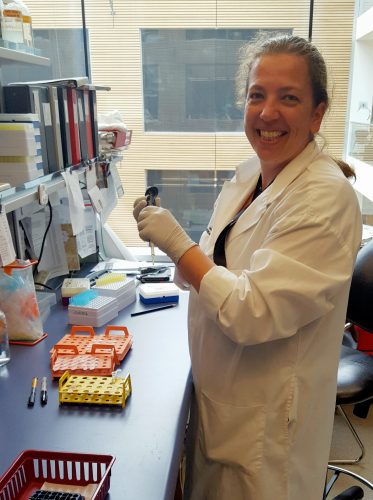 By Deb Chen, PhD Student in Devine Lab
By Deb Chen, PhD Student in Devine Lab

Christa Klein-Bosgoed
Pathogen inactivation (PI) technologies further improve blood product safety by using ultraviolet (UV) illumination and other additives to destroy pathogen nucleic acid content, thereby damaging their ability to replicate and spread. As expected, blood cells are not resistant to PI-treatment and their nucleic acid constituents also undergo a reduction in overall content. Christa Klein-Bosgoed, a PhD candidate in Dr. Dana Devine’s laboratory at the CBR, demonstrated that PI-treatment consisting of UV illumination in the presence of riboflavin, preferentially affects specific subsets of the nucleic acid material that is translated within platelet units prepared for transfusion (Published in Transfusion; doi:10.1111/trf.13715).
Platelets that circulate in the blood stream are fragments of their bone marrow-derived precursor, megakaryocytes, and are required to stop bleeding at the site of vessel damage. Platelets inherit mRNA from megakaryocytes and are able to synthesize proteins, despite the lack of a nucleus. While the significance for platelets to actively synthesize protein is not well understood, it is thought to be important for platelet activation and their clotting functions.
The safety of platelet concentrates increases with the application of PI technology; however, PI-treated platelets demonstrated an accelerated loss of quality, as evidenced by increased metabolism and reduced platelet activation upon stimulation. “We wanted to better understand how PI technology impacts platelet quality and to investigate its still unknown impact on mRNA stability and protein synthesis,” said Christa. These new findings may suggest a potential clinical impact on PI-treated platelet units, which is not yet known and under investigation.
UV illumination in the presence of riboflavin, a potent photosensitizer, preferentially damages guanine, one of the nitrogenous bases required to build DNA and RNA molecules. Christa clearly demonstrated that the total number of base pairs can robustly predict the impact of PI treatment, with more base pairs sustaining more damage in platelet mRNA transcripts. UV energy dose also correlates with platelet mRNA recovery, where a smaller UV dose predictably caused less damage to biomolecules. Interestingly, platelet mRNAs that remain after PI treatment appeared to exhibit longer half-lives, which may suggest activation of some mechanism(s) to protect mRNAs from further degradation.
There are still many aspects of PI technology and its impact on platelet product quality that we do not understand – as Christa comments, “This study is only one glimpse into the complex interaction between PI technology and platelet biology.” Ultimately, these studies may help to fine-tune PI technology to effectively prevent blood-borne diseases while preserving platelet function and therapeutic efficacy.


